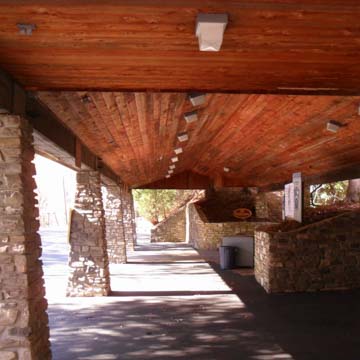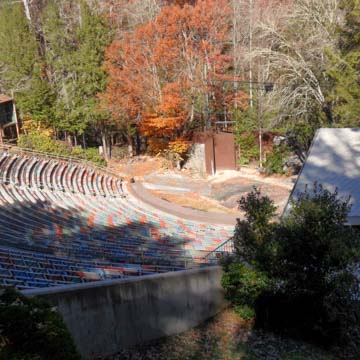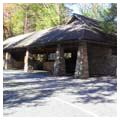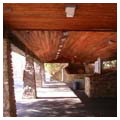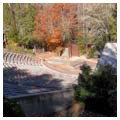The open-air Cherokee Mountainside Theatre is nestled into the side of a ridge within the Eastern Cherokee Reservation. Here, the story of the Cherokee people has been presented by the Cherokee Historical Association in the play Unto These Hills for more than half a century.
The Eastern Cherokee Reservation is the more commonly used name for the Qualla Boundary, a land trust for the Oconaluftee or the Eastern Band of Cherokee Indians. It is located in what is today Swain and Jackson counties with smaller non-adjacent areas in Cherokee and Graham counties. It borders the Great Smoky Mountains National Park in western North Carolina (the mountains’ name derives from the Cherokee term “Shaconage,” meaning “the place of the blue smoke”). The area is a fragment of what was the ancient homeland of the Cherokee Nation before the 1830 Indian Removal Act and military deportation. During this forced migration, which became known as the Trail of Tears, approximately 16,000 native people were removed from their southeastern lands to the Indian Territory (now Oklahoma). It is estimated more than 4,000 died on the way. An unknown number refused to leave and sought refuge in the mountains, while still others were permitted to remain for various reasons. The 1840 census lists 98 Cherokee households in area. Today the Eastern Cherokee are a recognized tribe by both the federal government and the State of North Carolina. The Cherokee Agency of the Bureau of Indian Affairs is located in Cherokee, the commercial core of the reservation.
The layout of Mountainside Theatre closely reflects that of a traditional Greek amphitheater. Stone and brick seating tiers, constructed by Cherokee masons, form a semicircle around the stage and orchestra pit. This layout amplifies sound and provides uninterrupted views of the surrounding mountains and forests. The current theater seats 2,900 people. The main entrance, renovated in 1987, has large, sheltering roofs and heavy beams supported by thick walls and pyramidal piers of rough stone. The theater itself was renovated in 2007 to include an upper-level wood and metal canopy as well as a concession stand with bathrooms. Also added at that time were steel cylinder lights punctured with Cherokee symbols and an elegant rainwater gutter system.
The theater architect, Albert Q. Bell, had previously designed the Mountainside Theatre (1936) in the coastal town of Manteo, where the popular The Lost Colony production was staged. The success of that play was the inspiration to create a similar tourist draw in the western part of the state. Unto These Hills has been staged in the Mountainside Theatre every summer since 1950. This historical drama depicts Cherokee life and culture from the time of first contact with Europeans—Spanish explorer Hernando de Soto arrived in 1540—to the nineteenth-century Trail of Tears. The play has been seen by more than six million and is one of the longest-running outdoor drama productions in the United States.
Near the theater, the Cherokee Historical Association also operates the Oconaluftee Indian Village, a reconstructed eighteenth-century Cherokee settlement and living museum.
References
“About the Eastern Band of Cherokee Indians.” Cherokee Preservation Foundation. Accessed February 26, 2019. http://cherokeepreservation.org/.
Bishir, Catherine W. North Carolina Architecture. Chapel Hill: University of North Carolina Press.
Bishir, Catherine W., and Michael T. Southern. A Guide to the Historical Architecture of Western North Carolina. Chapel Hill: University of North Carolina Press, 1999.
Clark, Jess. “Cherokee Central in the Carolinas.” Native Peoples Magazine20, no. 4 (2007): 60-64.
“Fort Raleigh National Historic Site,” Dare County, North Carolina. National Park Service Cultural Landscapes Inventory, 2010. National Park Service, U.S. Department of the Interior, Washington, D.C.
Mobley, Joe A., ed. The Way We Lived in North Carolina. Chapel Hill: The University of North Carolina Press, 2003.
Moore, Cecelia. “Outdoor Dramas.” NCpedia. Accessed January 28, 2019. http://ncpedia.org/.
Hill, Michael Hill., Research Branch, NC Office of Archives and History. “Qualla Boundary.” NCpedia. Accessed January 28, 2019. http://ncpedia.org/.
“Our History.” Cherokee Nation. Accessed February 26, 2019. http://www.cherokee.org/.
Riggs, Brett, and Lance Greene, “The Cherokee Trail of Tears in North Carolina: An Inventory of Trail Resources in Cherokee, Clay, Graham, Macon and Swain Counties.” Revised and updated report submitted to the National Park Service, Trail of Tears National Historic Trail, Santa Fe, New Mexico, 2006.


